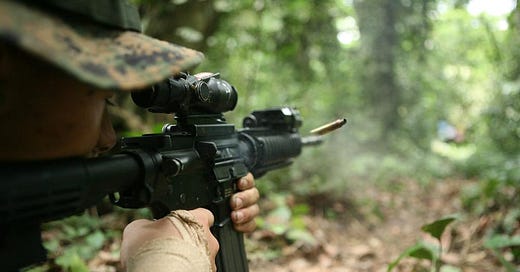Challenging Anti-Gun Rhetoric: The Potential of Citizen Militias in a Civil War Scenario
One of the main arguments of anti-second amendment advocates is that citizens would have no chance against the government using AR-15s and other types of rudimentary firepower available to the general public; that these citizens would be outgunned, outmanned, and out-tech’d by the United States Military. The idea of a civil war in the United States is concerning. Still, the debate around the Second Amendment and the potential role of citizens in such a conflict is an ongoing topic of discussion. History shows that guerrilla tactics can be an effective way for a smaller group to defeat a larger, more technologically advanced army.
The Taliban's victory over the Soviet Union in the 1980s is one example. The Soviet army, considered one of the most powerful in the world at the time, invaded Afghanistan in 1979 to support the communist government against the mujahideen, a group of guerrilla fighters. The mujahideen utilized guerrilla tactics, including ambushes and sabotage, to wear down the Soviet army. They received support from the United States and other Western powers through weapons and training. After a decade of fighting, the Soviet Union withdrew from Afghanistan, and the mujahideen emerged victorious.
Another example is the Vietnam War, where the North Vietnamese army utilized guerrilla tactics to combat the better-equipped U.S. military. The North Vietnamese were able to blend in with the local population and launch surprise attacks, which made it difficult for the U.S. military to gain any significant ground. The conflict dragged on for over a decade, ultimately ending in a North Vietnamese victory.
The two examples above are significant, but history is rife with examples of smaller, less equipped forces emerging victorious over larger, more sophisticated militaries. But rather than list examples of such victories, I’d like to dive into what a hypothetical civil war scenario in the United States might look like. It is essential to consider that the U.S. military would likely have significant advantages in air and ground superiority, advanced weaponry, and highly trained soldiers. However, a local citizen militia utilizing guerrilla tactics could pose a significant challenge to the military.
Much like the North Vietnamese Army, a citizen militia could blend in with the local population and utilize tactics such as ambushes, sabotage, and hit-and-run attacks to disrupt the military's operations. They could also have an advantage in their knowledge of the local terrain and their ability to mobilize local support.
Further, it’s logical to hypothesize that not all military members would engage in a civil war against their fellow citizens for the following reasons.
Many military members have family and friends living in the areas that might be targeted in the conflict. It is unlikely that soldiers would want to harm their loved ones or see their homes and communities destroyed.
Soldiers may have ideological differences with the government and disagree with the actions taken in the hypothetical conflict. They may see it as a violation of the Constitution or the principles of democracy and choose not to engage in such actions.
Soldiers take an oath to defend the Constitution and may see the government's actions in a hypothetical civil war as unconstitutional. They may choose to stand with the citizens they have sworn to defend rather than a government that they believe is acting against the people's best interests.
Other factors influencing a military member's decision to engage in a civil war against their fellow citizens could include personal moral and ethical beliefs, concerns about the conflict's legality, and the potential impact on their personal reputation and legacy.
It's also worth noting the possible reasons why the United States would avoid using heavy munitions in a hypothetical civil war scenario, such as large bombs, drone attacks, and air attacks.
Such heavy munitions could cause significant collateral damage to civilian infrastructure and potentially harm innocent bystanders. This could lead to a loss of support for the government and military forces, both domestically and internationally, which could further destabilize the situation.
Heavy munitions in urban areas could also destroy critical infrastructure, such as hospitals, power plants, and bridges, which could have long-lasting and severe consequences for the local population. This could also hamper the government's ability to maintain control and order in the affected areas.
These munitions could cause an escalation in the conflict, leading to a prolonged and bloody civil war. Any government and military forces would aim to quell the conflict as quickly and efficiently as possible, and heavy munitions could undermine that goal.
Heavy munitions could also cause an international backlash, with other nations condemning the United States for using excessive force against its citizens. This could damage diplomatic relations and further isolate the United States in the international community.
In conclusion, the effectiveness of guerrilla tactics throughout history highlights the potential for a local citizen militia to pose a significant challenge to a larger, more technologically advanced military force. The idea that citizens with rudimentary weapons could never defeat the U.S. military is flawed, as history shows that smaller, less technologically advanced groups have emerged victorious using guerrilla tactics. While the thought of a civil war is concerning and not endorsed by this author, it is important to consider all potential factors that could influence such a conflict. And it’s certainly not a foregone conclusion that the United States Government would emerge victorious in fighting its citizens.





